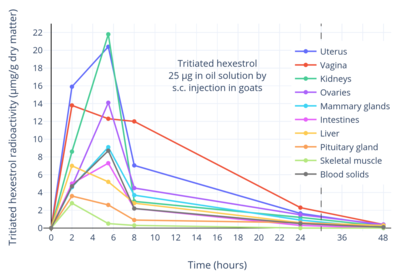Hexestrol
 | |
| Clinical data | |
|---|---|
| Trade names | Synestrol, Synoestrol, Estrifar, Estronal |
| Other names | Hexoestrol; Hexanestrol; Hexanoestrol; Dihydrodiethylstilbestrol; Dihydrostilbestrol; 4,4'-(1,2-Diethylethylene)diphenol; NSC-9894 |
| Routes of administration | By mouth, intramuscular injection (as an ester) |
| Drug class | Nonsteroidal estrogen |
| Identifiers | |
| |
| CAS Number | |
| PubChem CID | |
| IUPHAR/BPS | |
| DrugBank | |
| ChemSpider | |
| UNII | |
| KEGG | |
| ChEBI | |
| ChEMBL | |
| CompTox Dashboard (EPA) | |
| ECHA InfoCard | 100.001.380 |
| Chemical and physical data | |
| Formula | C18H22O2 |
| Molar mass | 270.372 g·mol−1 |
| 3D model (JSmol) | |
| |
| |
Hexestrol, sold under the brand name Synestrol among others, is a nonsteroidal estrogen which was previously used for estrogen replacement therapy and in the treatment of certain hormone-dependent cancers as well as gynecological disorders but is mostly no longer marketed.[1][2][3][4] It has also been used in the form of esters such as hexestrol diacetate (brand name Sintestrol) and hexestrol dipropionate (brand name Hexanoestrol).[1][5] Hexestrol and its esters are taken by mouth, held under the tongue, or via injection into muscle.[5][6][7]
Medical uses
[edit]Hexestrol has been used in estrogen replacement therapy, for the treatment of breast cancer in women and prostate cancer in men, and for the treatment of certain gynecological disorders.[2]
| Route/form | Estrogen | Dosage | |
|---|---|---|---|
| Oral | Estradiol | 1–2 mg 3x/day | |
| Conjugated estrogens | 1.25–2.5 mg 3x/day | ||
| Ethinylestradiol | 0.15–3 mg/day | ||
| Ethinylestradiol sulfonate | 1–2 mg 1x/week | ||
| Diethylstilbestrol | 1–3 mg/day | ||
| Dienestrol | 5 mg/day | ||
| Hexestrol | 5 mg/day | ||
| Fosfestrol | 100–480 mg 1–3x/day | ||
| Chlorotrianisene | 12–48 mg/day | ||
| Quadrosilan | 900 mg/day | ||
| Estramustine phosphate | 140–1400 mg/day | ||
| Transdermal patch | Estradiol | 2–6x 100 μg/day Scrotal: 1x 100 μg/day | |
| IM or SC injection | Estradiol benzoate | 1.66 mg 3x/week | |
| Estradiol dipropionate | 5 mg 1x/week | ||
| Estradiol valerate | 10–40 mg 1x/1–2 weeks | ||
| Estradiol undecylate | 100 mg 1x/4 weeks | ||
| Polyestradiol phosphate | Alone: 160–320 mg 1x/4 weeks With oral EE: 40–80 mg 1x/4 weeks | ||
| Estrone | 2–4 mg 2–3x/week | ||
| IV injection | Fosfestrol | 300–1200 mg 1–7x/week | |
| Estramustine phosphate | 240–450 mg/day | ||
| Note: Dosages are not necessarily equivalent. Sources: See template. | |||
Pharmacology
[edit]Pharmacodynamics
[edit]Hexestrol has approximately 302% and 234% of the affinity of estradiol for the estrogen receptors (ERs) ERα and ERβ, respectively.[8] The affinity of hexestrol for the ERs is said to be similar to or slightly higher than that of estradiol.[9] Along with diethylstilbestrol, hexestrol has been said to be one of the most potent estrogens known.[10] The total endometrial proliferation dose per cycle of different forms of hexestrol are 70 to 100 mg for oral hexestrol, 45 mg for sublingual hexestrol diacetate, and 25 mg for hexestrol dipropionate by intramuscular injection.[5] These doses are fairly similar to those of estradiol and its esters.[5] Hexestrol induces mammary gland development in rodents similarly to other estrogens.[11]
Nonsteroidal estrogens like diethylstilbestrol, which is closely related structurally to hexestrol, are known to have dramatically disproportionate estrogenic effects in the liver and on liver protein synthesis.[12]
| Estrogen | Form | Major brand name(s) | EPD (14 days) | Duration | |
|---|---|---|---|---|---|
| Diethylstilbestrol (DES) | Oil solution | Metestrol | 20 mg | 1 mg ≈ 2–3 days; 3 mg ≈ 3 days | |
| Diethylstilbestrol dipropionate | Oil solution | Cyren B | 12.5–15 mg | 2.5 mg ≈ 5 days | |
| Aqueous suspension | ? | 5 mg | ? mg = 21–28 days | ||
| Dimestrol (DES dimethyl ether) | Oil solution | Depot-Cyren, Depot-Oestromon, Retalon Retard | 20–40 mg | ? | |
| Fosfestrol (DES diphosphate)a | Aqueous solution | Honvan | ? | <1 day | |
| Dienestrol diacetate | Aqueous suspension | Farmacyrol-Kristallsuspension | 50 mg | ? | |
| Hexestrol dipropionate | Oil solution | Hormoestrol, Retalon Oleosum | 25 mg | ? | |
| Hexestrol diphosphatea | Aqueous solution | Cytostesin, Pharmestrin, Retalon Aquosum | ? | Very short | |
| Note: All by intramuscular injection unless otherwise noted. Footnotes: a = By intravenous injection. Sources: See template. | |||||
Pharmacokinetics
[edit]
The pharmacokinetics and distribution of hexestrol have been studied with intravenous injection of aqueous solution in women and with subcutaneous injection of oil solution in female goats and sheep.[15][13]
Chemistry
[edit]Hexestrol, also known as dihydrodiethylstilbestrol, is a synthetic nonsteroidal estrogen of the stilbestrol group related to diethylstilbestrol.[1][2] Esters of hexestrol include hexestrol diacetate, hexestrol dicaprylate, hexestrol diphosphate, and hexestrol dipropionate.[1]
History
[edit]Hexestrol was first described by Campbell, Dodds, and Lawson in 1938.[16][11][17][18] It was isolated from the demethylation products of anethole.[16][11][17][18]
Society and culture
[edit]Generic names
[edit]Hexestrol is the generic name of the drug and its INN.[1][2]
Brand names
[edit]Hexestrol has been marketed under a variety of brand names including Synestrol, Synoestrol, Estrifar, and Estronal, among others.[1][2]
Availability
[edit]Hexestrol has mostly been discontinued and remains available in only a handful of countries.[19][4] Esters of hexestrol which have been marketed include hexestrol diacetate, hexestrol dicaprylate, hexestrol diphosphate, and hexestrol dipropionate.[1]
References
[edit]- ^ a b c d e f g Elks J (14 November 2014). The Dictionary of Drugs: Chemical Data: Chemical Data, Structures and Bibliographies. Springer. pp. 162–. ISBN 978-1-4757-2085-3.
- ^ a b c d e Morton IK, Hall JM (6 December 2012). Concise Dictionary of Pharmacological Agents: Properties and Synonyms. Springer Science & Business Media. pp. 140–. ISBN 978-94-011-4439-1.
- ^ Thomas JA (12 March 1997). Endocrine Toxicology, Second Edition. CRC Press. pp. 144–. ISBN 978-1-4398-1048-4.
- ^ a b "Estradiol: Uses, Dosage & Side Effects".
- ^ a b c d Horsky J, Presl J (6 December 2012). Ovarian Function and its Disorders: Diagnosis and Therapy. Springer Science & Business Media. pp. 83, 85, 145, 310. ISBN 978-94-009-8195-9.
- ^ Thomas JA, Keenan EJ (6 December 2012). Principles of Endocrine Pharmacology. Springer Science & Business Media. pp. 153–. ISBN 978-1-4684-5036-1.
- ^ Barar FS (2012). Textbook of Pharmacology. S. Chand Publishing. pp. 348–. ISBN 978-81-219-4080-1.
- ^ Kuiper GG, Carlsson B, Grandien K, Enmark E, Häggblad J, Nilsson S, Gustafsson JA (March 1997). "Comparison of the ligand binding specificity and transcript tissue distribution of estrogen receptors alpha and beta". Endocrinology. 138 (3): 863–870. doi:10.1210/endo.138.3.4979. PMID 9048584.
- ^ Leclercq G, Heuson JC (December 1979). "Physiological and pharmacological effects of estrogens in breast cancer". Biochimica et Biophysica Acta (BBA) - Reviews on Cancer. 560 (4): 427–455. doi:10.1016/0304-419x(79)90012-x. PMID 391285.
- ^ Solmssen UV (December 1945). "Synthetic estrogens and the relation between their structure and their activity". Chemical Reviews. 37 (3): 481–598. doi:10.1021/cr60118a004. PMID 21013428.
- ^ a b c Campbell NR, Dodds EC, Lawson W, Noble RL (1939). "Biological effects of the synthetic œstrogen hexœstrol". The Lancet. 234 (6049): 312–313. doi:10.1016/S0140-6736(00)61997-9. ISSN 0140-6736.
- ^ Kuhl H (August 2005). "Pharmacology of estrogens and progestogens: influence of different routes of administration". Climacteric. 8 (Suppl 1): 3–63. doi:10.1080/13697130500148875. PMID 16112947. S2CID 24616324.
- ^ a b c d Glascock RF, Hoekstra WG (August 1959). "Selective accumulation of tritium-labelled hexoestrol by the reproductive organs of immature female goats and sheep". The Biochemical Journal. 72 (4): 673–682. doi:10.1042/bj0720673. PMC 1196992. PMID 13828338.
- ^ Jensen EV, DeSombre ER (1972). "Mechanism of action of the female sex hormones". Annual Review of Biochemistry. 41: 203–230. doi:10.1146/annurev.bi.41.070172.001223. PMID 4563437.
- ^ Folca PJ, Glascock RF, Irvine WT (October 1961). "Studies with tritium-labelled hexoestrol in advanced breast cancer. Comparison of tissue accumulation of hexoestrol with response to bilateral adrenalectomy and oophorectomy". Lancet. 2 (7206): 796–798. doi:10.1016/s0140-6736(61)91088-1. PMID 13893792.
- ^ a b Campbell NR, Dodds EC, Lawson W (1938). "Œstrogenic Activity of Anol; a Highly Active Phenol Isolated from the By-Products". Nature. 142 (3608): 1121. Bibcode:1938Natur.142.1121C. doi:10.1038/1421121a0. ISSN 0028-0836. S2CID 4140616.
- ^ a b Medicinal Chemistry. John Wiley & Sons. 1956. p. 40.
- ^ a b Campbell NR, Dodds EC, Lawson W (1940). "The nature of the oestrogenic substances produced during the demethylation of anethole". Proceedings of the Royal Society of London. Series B, Biological Sciences. 128 (851): 253–262. Bibcode:1940RSPSB.128..253C. doi:10.1098/rspb.1940.0009. ISSN 2053-9193.
- ^ "Micromdex". Merative. Retrieved 10 March 2023.
